University Cyber Security Report: Professional Skills Development
VerifiedAdded on 2020/02/24
|12
|3770
|112
Report
AI Summary
This report examines the impact of cyber security threats on organizations, focusing on a software company in Australia. It explores the need for modern technologies to prevent data corruption and loss, discussing solutions like Symantec Advanced Threat Protection (SATP), ProtectWise Cloud Network DVR, and Fireglass. The report analyzes the advantages, risks, and implementation of these technologies, providing recommendations for the case study organization, including strategies for technology implementation, risk mitigation, and employee training. The report's objectives include investigating how ICT can be used to gain a competitive advantage, expanding the organization's global market presence, and offering recommendations for improving ICT use. The report concludes by emphasizing the importance of up-to-date software, strong firewalls, and trained employees to combat cyber threats effectively, and discusses the need for future research.
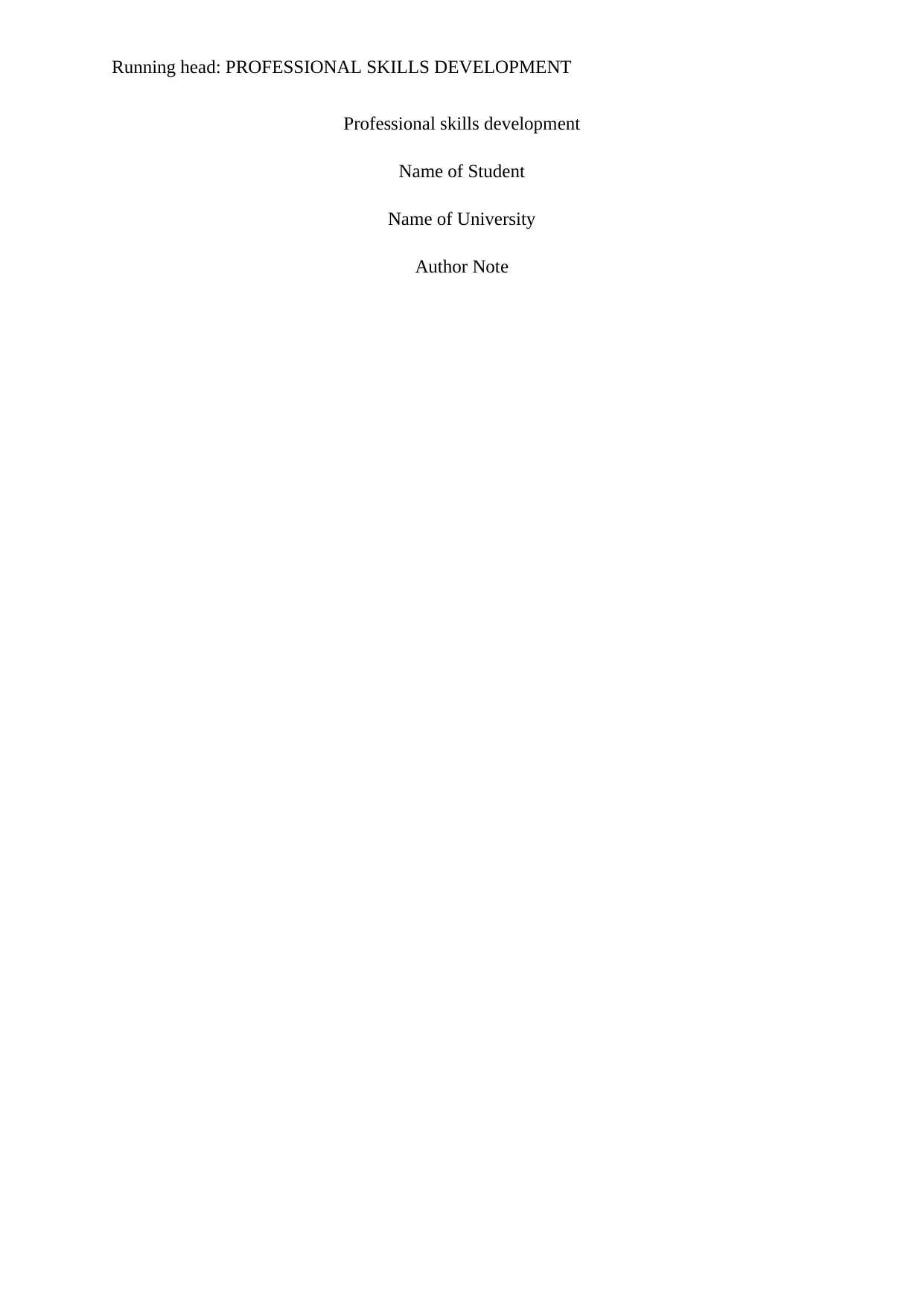
Running head: PROFESSIONAL SKILLS DEVELOPMENT
Professional skills development
Name of Student
Name of University
Author Note
Professional skills development
Name of Student
Name of University
Author Note
Paraphrase This Document
Need a fresh take? Get an instant paraphrase of this document with our AI Paraphraser
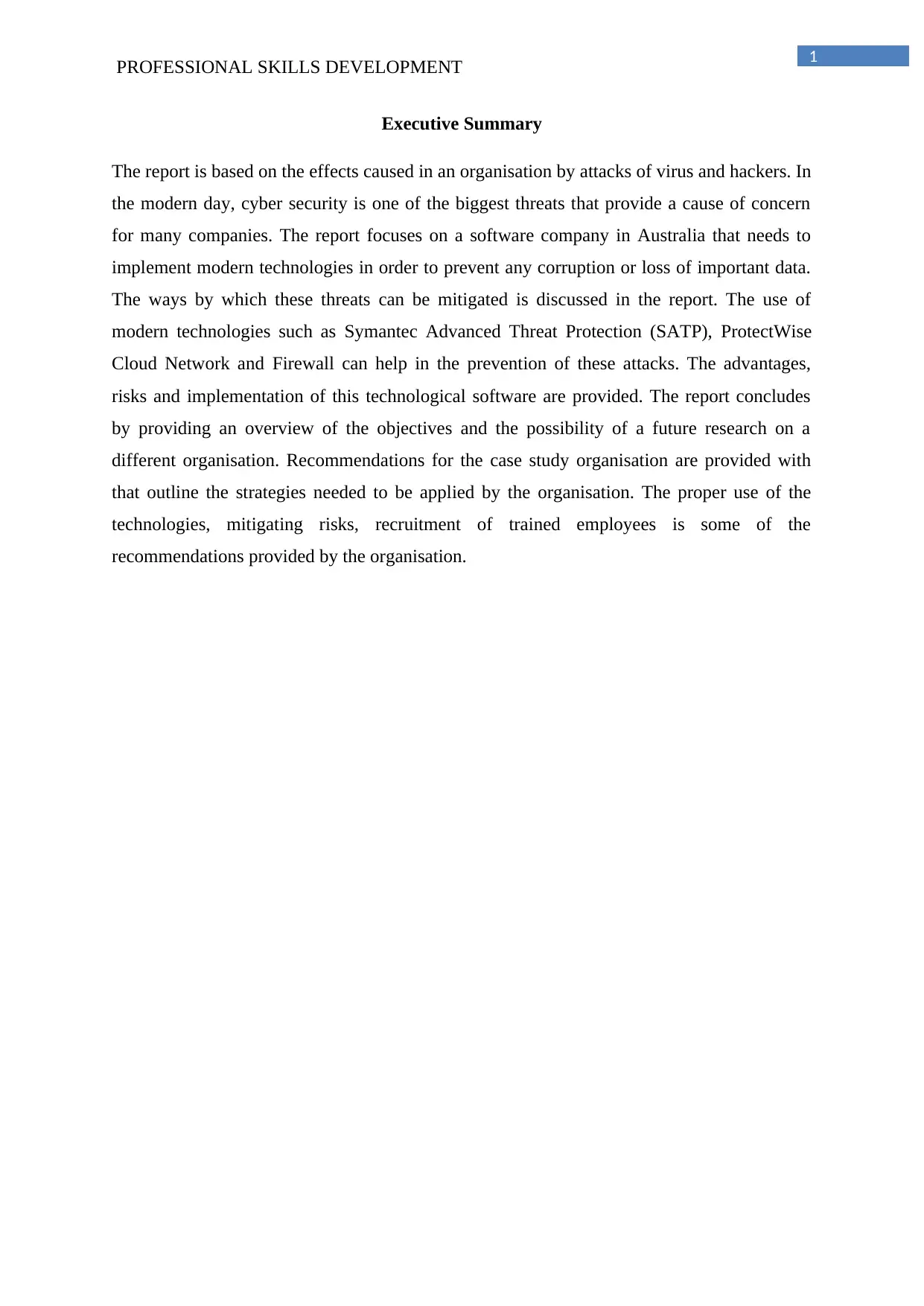
1
PROFESSIONAL SKILLS DEVELOPMENT
Executive Summary
The report is based on the effects caused in an organisation by attacks of virus and hackers. In
the modern day, cyber security is one of the biggest threats that provide a cause of concern
for many companies. The report focuses on a software company in Australia that needs to
implement modern technologies in order to prevent any corruption or loss of important data.
The ways by which these threats can be mitigated is discussed in the report. The use of
modern technologies such as Symantec Advanced Threat Protection (SATP), ProtectWise
Cloud Network and Firewall can help in the prevention of these attacks. The advantages,
risks and implementation of this technological software are provided. The report concludes
by providing an overview of the objectives and the possibility of a future research on a
different organisation. Recommendations for the case study organisation are provided with
that outline the strategies needed to be applied by the organisation. The proper use of the
technologies, mitigating risks, recruitment of trained employees is some of the
recommendations provided by the organisation.
PROFESSIONAL SKILLS DEVELOPMENT
Executive Summary
The report is based on the effects caused in an organisation by attacks of virus and hackers. In
the modern day, cyber security is one of the biggest threats that provide a cause of concern
for many companies. The report focuses on a software company in Australia that needs to
implement modern technologies in order to prevent any corruption or loss of important data.
The ways by which these threats can be mitigated is discussed in the report. The use of
modern technologies such as Symantec Advanced Threat Protection (SATP), ProtectWise
Cloud Network and Firewall can help in the prevention of these attacks. The advantages,
risks and implementation of this technological software are provided. The report concludes
by providing an overview of the objectives and the possibility of a future research on a
different organisation. Recommendations for the case study organisation are provided with
that outline the strategies needed to be applied by the organisation. The proper use of the
technologies, mitigating risks, recruitment of trained employees is some of the
recommendations provided by the organisation.
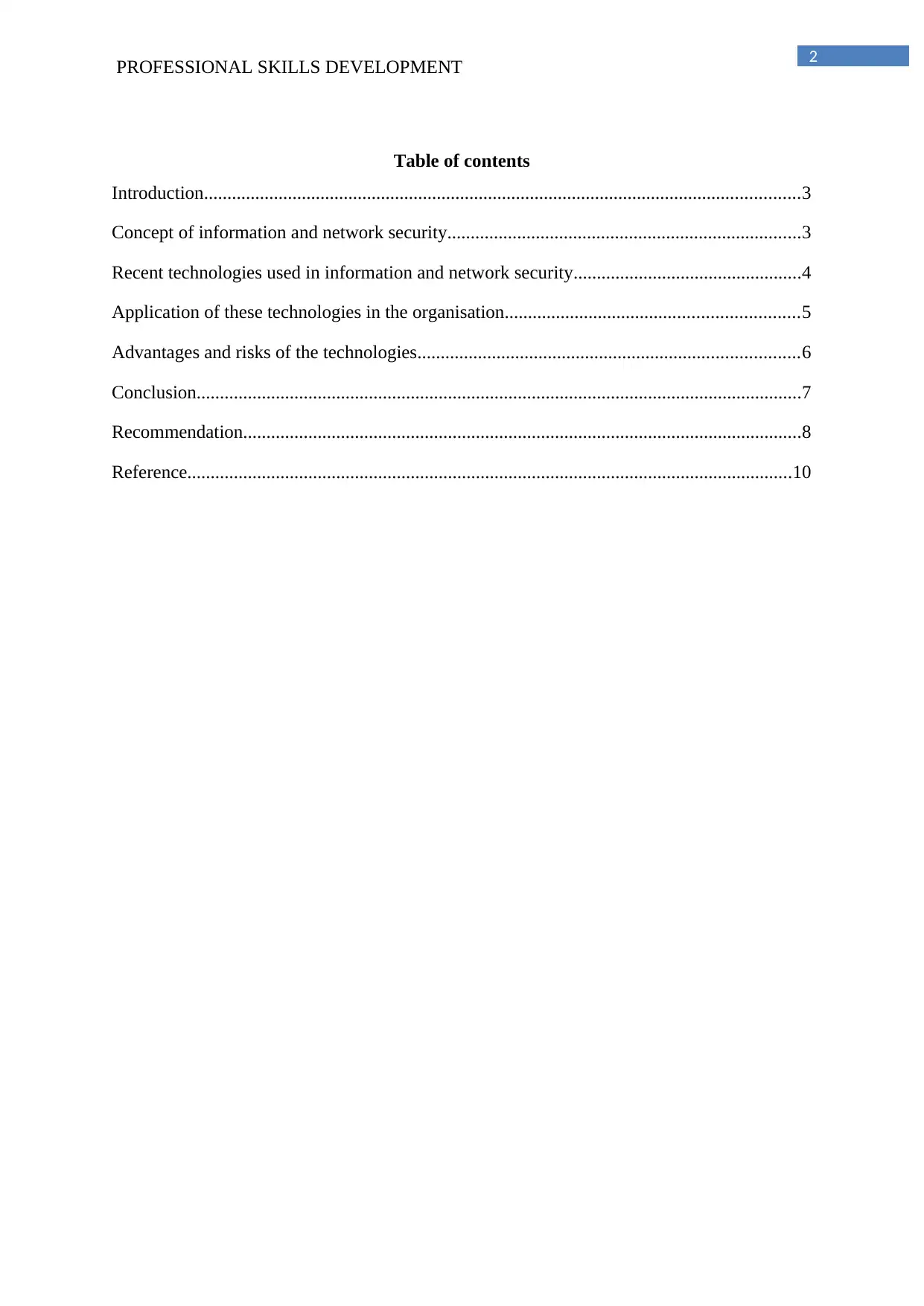
2
PROFESSIONAL SKILLS DEVELOPMENT
Table of contents
Introduction................................................................................................................................3
Concept of information and network security............................................................................3
Recent technologies used in information and network security.................................................4
Application of these technologies in the organisation...............................................................5
Advantages and risks of the technologies..................................................................................6
Conclusion..................................................................................................................................7
Recommendation........................................................................................................................8
Reference..................................................................................................................................10
PROFESSIONAL SKILLS DEVELOPMENT
Table of contents
Introduction................................................................................................................................3
Concept of information and network security............................................................................3
Recent technologies used in information and network security.................................................4
Application of these technologies in the organisation...............................................................5
Advantages and risks of the technologies..................................................................................6
Conclusion..................................................................................................................................7
Recommendation........................................................................................................................8
Reference..................................................................................................................................10
⊘ This is a preview!⊘
Do you want full access?
Subscribe today to unlock all pages.

Trusted by 1+ million students worldwide
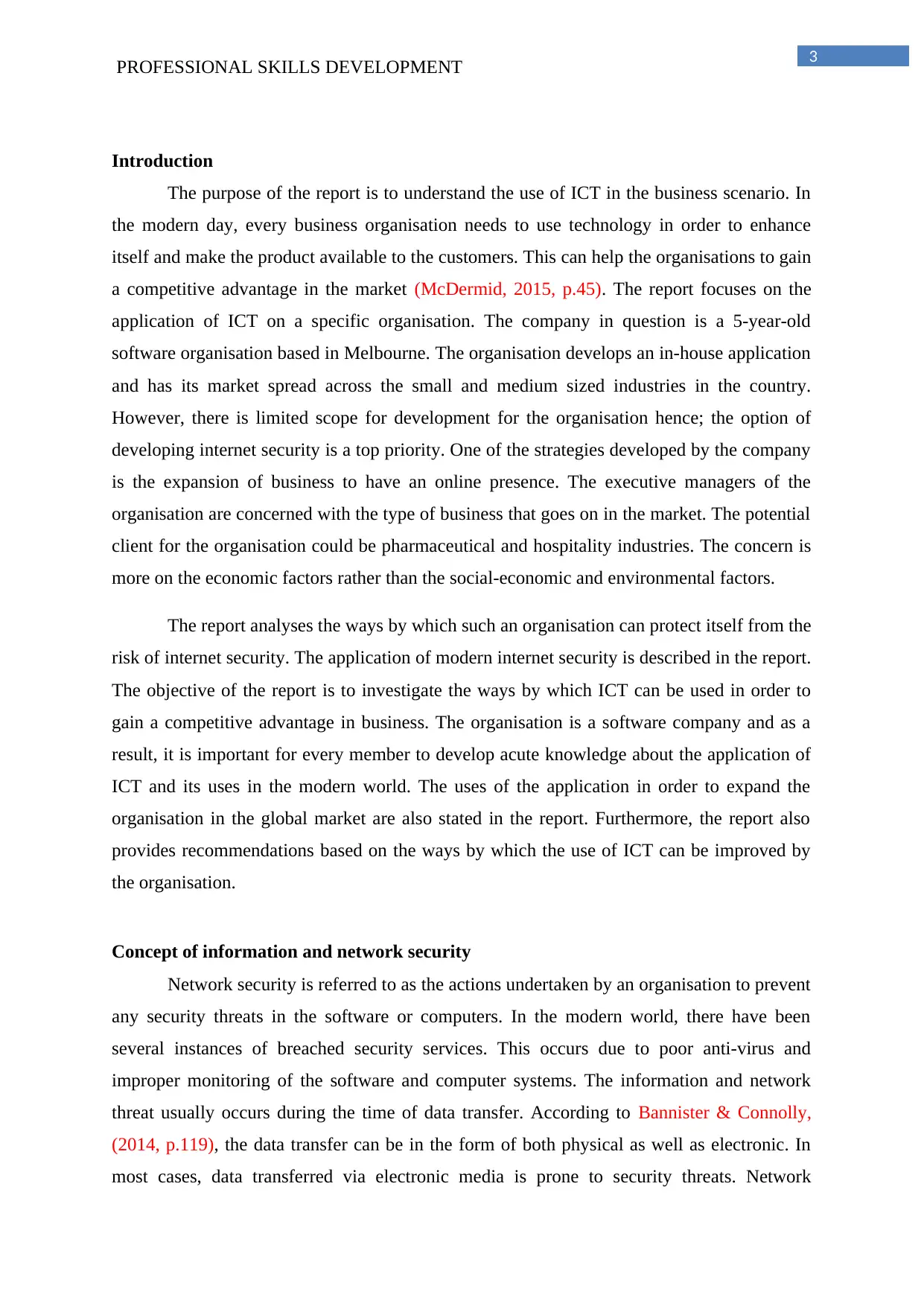
3
PROFESSIONAL SKILLS DEVELOPMENT
Introduction
The purpose of the report is to understand the use of ICT in the business scenario. In
the modern day, every business organisation needs to use technology in order to enhance
itself and make the product available to the customers. This can help the organisations to gain
a competitive advantage in the market (McDermid, 2015, p.45). The report focuses on the
application of ICT on a specific organisation. The company in question is a 5-year-old
software organisation based in Melbourne. The organisation develops an in-house application
and has its market spread across the small and medium sized industries in the country.
However, there is limited scope for development for the organisation hence; the option of
developing internet security is a top priority. One of the strategies developed by the company
is the expansion of business to have an online presence. The executive managers of the
organisation are concerned with the type of business that goes on in the market. The potential
client for the organisation could be pharmaceutical and hospitality industries. The concern is
more on the economic factors rather than the social-economic and environmental factors.
The report analyses the ways by which such an organisation can protect itself from the
risk of internet security. The application of modern internet security is described in the report.
The objective of the report is to investigate the ways by which ICT can be used in order to
gain a competitive advantage in business. The organisation is a software company and as a
result, it is important for every member to develop acute knowledge about the application of
ICT and its uses in the modern world. The uses of the application in order to expand the
organisation in the global market are also stated in the report. Furthermore, the report also
provides recommendations based on the ways by which the use of ICT can be improved by
the organisation.
Concept of information and network security
Network security is referred to as the actions undertaken by an organisation to prevent
any security threats in the software or computers. In the modern world, there have been
several instances of breached security services. This occurs due to poor anti-virus and
improper monitoring of the software and computer systems. The information and network
threat usually occurs during the time of data transfer. According to Bannister & Connolly,
(2014, p.119), the data transfer can be in the form of both physical as well as electronic. In
most cases, data transferred via electronic media is prone to security threats. Network
PROFESSIONAL SKILLS DEVELOPMENT
Introduction
The purpose of the report is to understand the use of ICT in the business scenario. In
the modern day, every business organisation needs to use technology in order to enhance
itself and make the product available to the customers. This can help the organisations to gain
a competitive advantage in the market (McDermid, 2015, p.45). The report focuses on the
application of ICT on a specific organisation. The company in question is a 5-year-old
software organisation based in Melbourne. The organisation develops an in-house application
and has its market spread across the small and medium sized industries in the country.
However, there is limited scope for development for the organisation hence; the option of
developing internet security is a top priority. One of the strategies developed by the company
is the expansion of business to have an online presence. The executive managers of the
organisation are concerned with the type of business that goes on in the market. The potential
client for the organisation could be pharmaceutical and hospitality industries. The concern is
more on the economic factors rather than the social-economic and environmental factors.
The report analyses the ways by which such an organisation can protect itself from the
risk of internet security. The application of modern internet security is described in the report.
The objective of the report is to investigate the ways by which ICT can be used in order to
gain a competitive advantage in business. The organisation is a software company and as a
result, it is important for every member to develop acute knowledge about the application of
ICT and its uses in the modern world. The uses of the application in order to expand the
organisation in the global market are also stated in the report. Furthermore, the report also
provides recommendations based on the ways by which the use of ICT can be improved by
the organisation.
Concept of information and network security
Network security is referred to as the actions undertaken by an organisation to prevent
any security threats in the software or computers. In the modern world, there have been
several instances of breached security services. This occurs due to poor anti-virus and
improper monitoring of the software and computer systems. The information and network
threat usually occurs during the time of data transfer. According to Bannister & Connolly,
(2014, p.119), the data transfer can be in the form of both physical as well as electronic. In
most cases, data transferred via electronic media is prone to security threats. Network
Paraphrase This Document
Need a fresh take? Get an instant paraphrase of this document with our AI Paraphraser
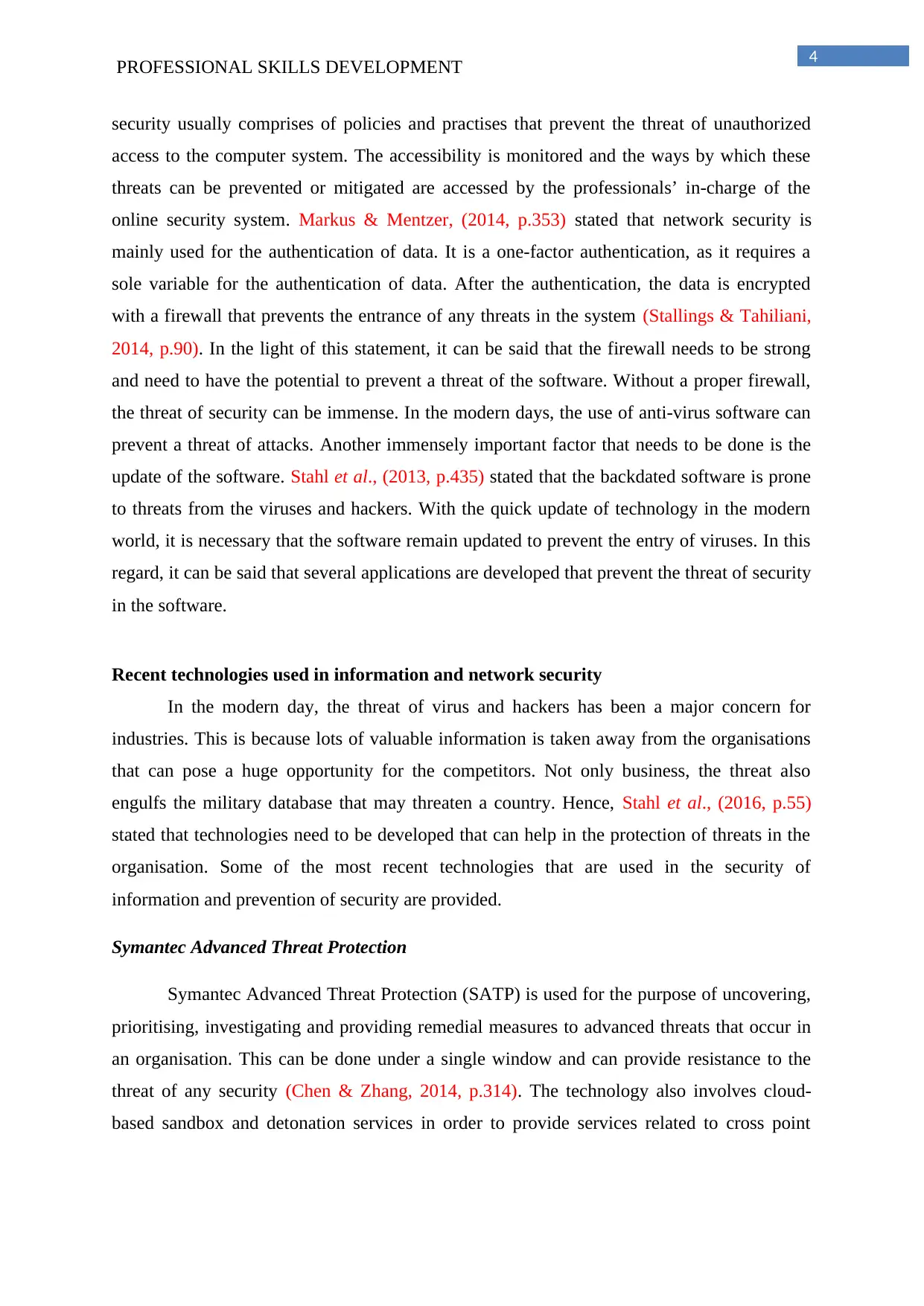
4
PROFESSIONAL SKILLS DEVELOPMENT
security usually comprises of policies and practises that prevent the threat of unauthorized
access to the computer system. The accessibility is monitored and the ways by which these
threats can be prevented or mitigated are accessed by the professionals’ in-charge of the
online security system. Markus & Mentzer, (2014, p.353) stated that network security is
mainly used for the authentication of data. It is a one-factor authentication, as it requires a
sole variable for the authentication of data. After the authentication, the data is encrypted
with a firewall that prevents the entrance of any threats in the system (Stallings & Tahiliani,
2014, p.90). In the light of this statement, it can be said that the firewall needs to be strong
and need to have the potential to prevent a threat of the software. Without a proper firewall,
the threat of security can be immense. In the modern days, the use of anti-virus software can
prevent a threat of attacks. Another immensely important factor that needs to be done is the
update of the software. Stahl et al., (2013, p.435) stated that the backdated software is prone
to threats from the viruses and hackers. With the quick update of technology in the modern
world, it is necessary that the software remain updated to prevent the entry of viruses. In this
regard, it can be said that several applications are developed that prevent the threat of security
in the software.
Recent technologies used in information and network security
In the modern day, the threat of virus and hackers has been a major concern for
industries. This is because lots of valuable information is taken away from the organisations
that can pose a huge opportunity for the competitors. Not only business, the threat also
engulfs the military database that may threaten a country. Hence, Stahl et al., (2016, p.55)
stated that technologies need to be developed that can help in the protection of threats in the
organisation. Some of the most recent technologies that are used in the security of
information and prevention of security are provided.
Symantec Advanced Threat Protection
Symantec Advanced Threat Protection (SATP) is used for the purpose of uncovering,
prioritising, investigating and providing remedial measures to advanced threats that occur in
an organisation. This can be done under a single window and can provide resistance to the
threat of any security (Chen & Zhang, 2014, p.314). The technology also involves cloud-
based sandbox and detonation services in order to provide services related to cross point
PROFESSIONAL SKILLS DEVELOPMENT
security usually comprises of policies and practises that prevent the threat of unauthorized
access to the computer system. The accessibility is monitored and the ways by which these
threats can be prevented or mitigated are accessed by the professionals’ in-charge of the
online security system. Markus & Mentzer, (2014, p.353) stated that network security is
mainly used for the authentication of data. It is a one-factor authentication, as it requires a
sole variable for the authentication of data. After the authentication, the data is encrypted
with a firewall that prevents the entrance of any threats in the system (Stallings & Tahiliani,
2014, p.90). In the light of this statement, it can be said that the firewall needs to be strong
and need to have the potential to prevent a threat of the software. Without a proper firewall,
the threat of security can be immense. In the modern days, the use of anti-virus software can
prevent a threat of attacks. Another immensely important factor that needs to be done is the
update of the software. Stahl et al., (2013, p.435) stated that the backdated software is prone
to threats from the viruses and hackers. With the quick update of technology in the modern
world, it is necessary that the software remain updated to prevent the entry of viruses. In this
regard, it can be said that several applications are developed that prevent the threat of security
in the software.
Recent technologies used in information and network security
In the modern day, the threat of virus and hackers has been a major concern for
industries. This is because lots of valuable information is taken away from the organisations
that can pose a huge opportunity for the competitors. Not only business, the threat also
engulfs the military database that may threaten a country. Hence, Stahl et al., (2016, p.55)
stated that technologies need to be developed that can help in the protection of threats in the
organisation. Some of the most recent technologies that are used in the security of
information and prevention of security are provided.
Symantec Advanced Threat Protection
Symantec Advanced Threat Protection (SATP) is used for the purpose of uncovering,
prioritising, investigating and providing remedial measures to advanced threats that occur in
an organisation. This can be done under a single window and can provide resistance to the
threat of any security (Chen & Zhang, 2014, p.314). The technology also involves cloud-
based sandbox and detonation services in order to provide services related to cross point
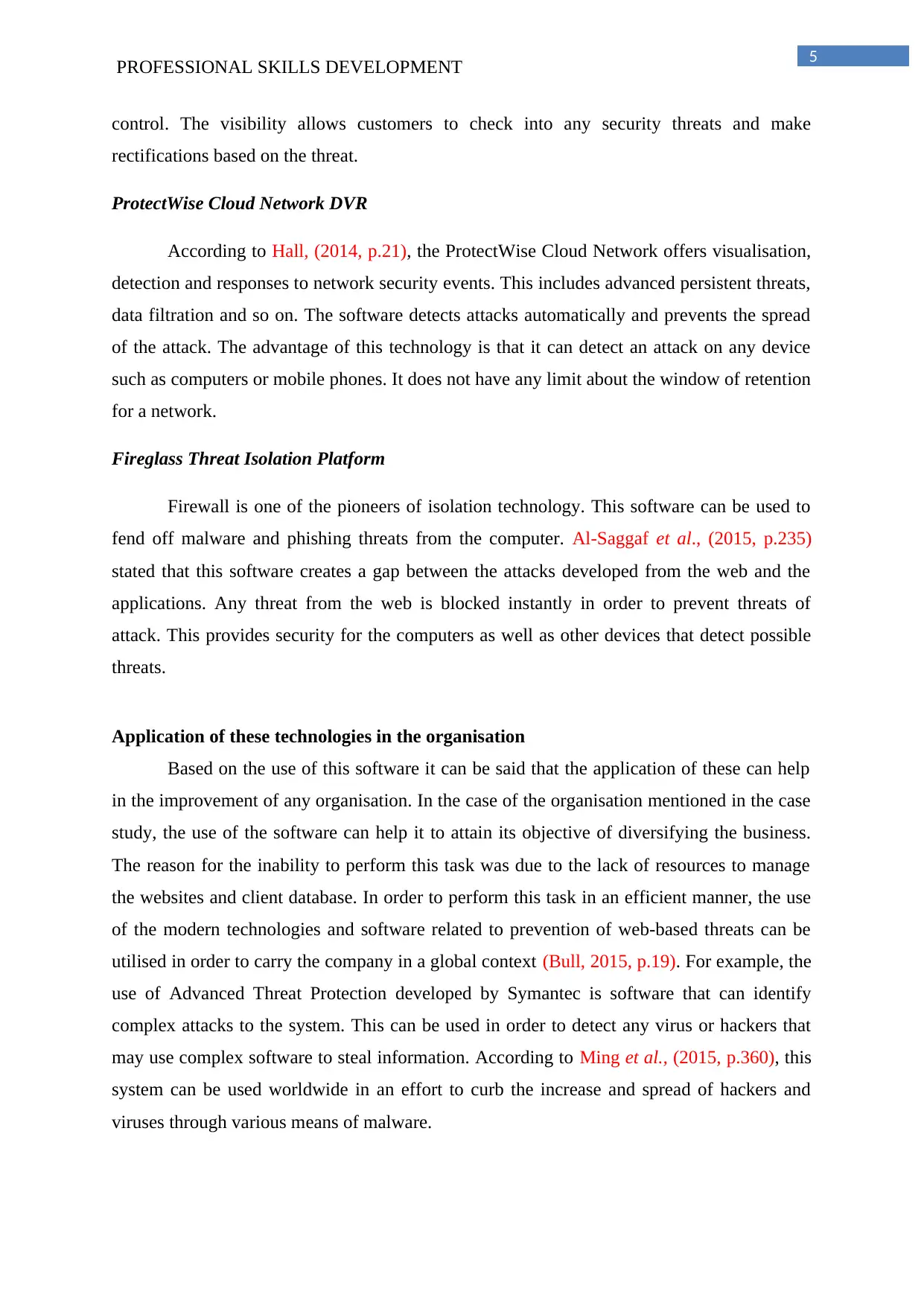
5
PROFESSIONAL SKILLS DEVELOPMENT
control. The visibility allows customers to check into any security threats and make
rectifications based on the threat.
ProtectWise Cloud Network DVR
According to Hall, (2014, p.21), the ProtectWise Cloud Network offers visualisation,
detection and responses to network security events. This includes advanced persistent threats,
data filtration and so on. The software detects attacks automatically and prevents the spread
of the attack. The advantage of this technology is that it can detect an attack on any device
such as computers or mobile phones. It does not have any limit about the window of retention
for a network.
Fireglass Threat Isolation Platform
Firewall is one of the pioneers of isolation technology. This software can be used to
fend off malware and phishing threats from the computer. Al-Saggaf et al., (2015, p.235)
stated that this software creates a gap between the attacks developed from the web and the
applications. Any threat from the web is blocked instantly in order to prevent threats of
attack. This provides security for the computers as well as other devices that detect possible
threats.
Application of these technologies in the organisation
Based on the use of this software it can be said that the application of these can help
in the improvement of any organisation. In the case of the organisation mentioned in the case
study, the use of the software can help it to attain its objective of diversifying the business.
The reason for the inability to perform this task was due to the lack of resources to manage
the websites and client database. In order to perform this task in an efficient manner, the use
of the modern technologies and software related to prevention of web-based threats can be
utilised in order to carry the company in a global context (Bull, 2015, p.19). For example, the
use of Advanced Threat Protection developed by Symantec is software that can identify
complex attacks to the system. This can be used in order to detect any virus or hackers that
may use complex software to steal information. According to Ming et al., (2015, p.360), this
system can be used worldwide in an effort to curb the increase and spread of hackers and
viruses through various means of malware.
PROFESSIONAL SKILLS DEVELOPMENT
control. The visibility allows customers to check into any security threats and make
rectifications based on the threat.
ProtectWise Cloud Network DVR
According to Hall, (2014, p.21), the ProtectWise Cloud Network offers visualisation,
detection and responses to network security events. This includes advanced persistent threats,
data filtration and so on. The software detects attacks automatically and prevents the spread
of the attack. The advantage of this technology is that it can detect an attack on any device
such as computers or mobile phones. It does not have any limit about the window of retention
for a network.
Fireglass Threat Isolation Platform
Firewall is one of the pioneers of isolation technology. This software can be used to
fend off malware and phishing threats from the computer. Al-Saggaf et al., (2015, p.235)
stated that this software creates a gap between the attacks developed from the web and the
applications. Any threat from the web is blocked instantly in order to prevent threats of
attack. This provides security for the computers as well as other devices that detect possible
threats.
Application of these technologies in the organisation
Based on the use of this software it can be said that the application of these can help
in the improvement of any organisation. In the case of the organisation mentioned in the case
study, the use of the software can help it to attain its objective of diversifying the business.
The reason for the inability to perform this task was due to the lack of resources to manage
the websites and client database. In order to perform this task in an efficient manner, the use
of the modern technologies and software related to prevention of web-based threats can be
utilised in order to carry the company in a global context (Bull, 2015, p.19). For example, the
use of Advanced Threat Protection developed by Symantec is software that can identify
complex attacks to the system. This can be used in order to detect any virus or hackers that
may use complex software to steal information. According to Ming et al., (2015, p.360), this
system can be used worldwide in an effort to curb the increase and spread of hackers and
viruses through various means of malware.
⊘ This is a preview!⊘
Do you want full access?
Subscribe today to unlock all pages.

Trusted by 1+ million students worldwide
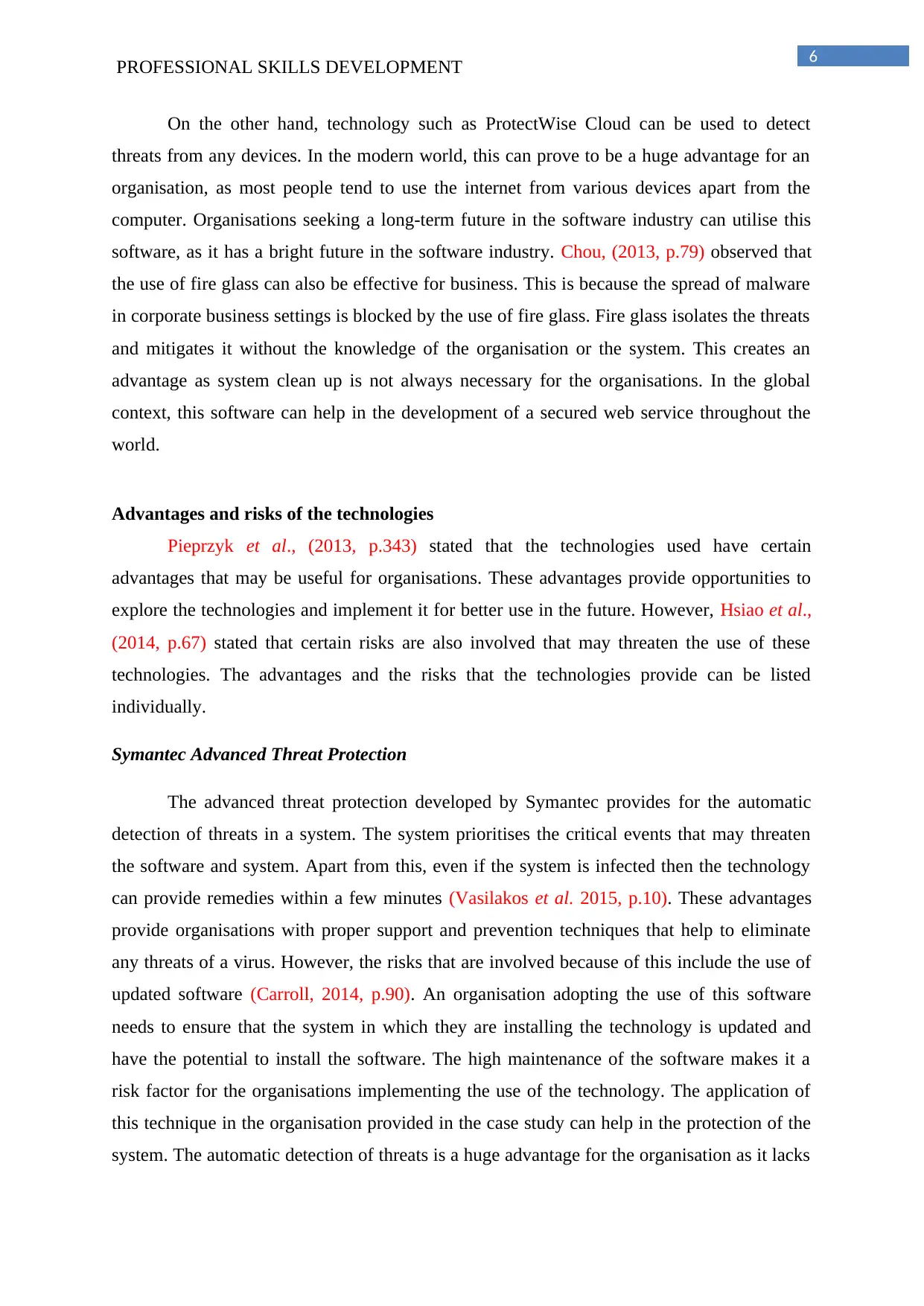
6
PROFESSIONAL SKILLS DEVELOPMENT
On the other hand, technology such as ProtectWise Cloud can be used to detect
threats from any devices. In the modern world, this can prove to be a huge advantage for an
organisation, as most people tend to use the internet from various devices apart from the
computer. Organisations seeking a long-term future in the software industry can utilise this
software, as it has a bright future in the software industry. Chou, (2013, p.79) observed that
the use of fire glass can also be effective for business. This is because the spread of malware
in corporate business settings is blocked by the use of fire glass. Fire glass isolates the threats
and mitigates it without the knowledge of the organisation or the system. This creates an
advantage as system clean up is not always necessary for the organisations. In the global
context, this software can help in the development of a secured web service throughout the
world.
Advantages and risks of the technologies
Pieprzyk et al., (2013, p.343) stated that the technologies used have certain
advantages that may be useful for organisations. These advantages provide opportunities to
explore the technologies and implement it for better use in the future. However, Hsiao et al.,
(2014, p.67) stated that certain risks are also involved that may threaten the use of these
technologies. The advantages and the risks that the technologies provide can be listed
individually.
Symantec Advanced Threat Protection
The advanced threat protection developed by Symantec provides for the automatic
detection of threats in a system. The system prioritises the critical events that may threaten
the software and system. Apart from this, even if the system is infected then the technology
can provide remedies within a few minutes (Vasilakos et al. 2015, p.10). These advantages
provide organisations with proper support and prevention techniques that help to eliminate
any threats of a virus. However, the risks that are involved because of this include the use of
updated software (Carroll, 2014, p.90). An organisation adopting the use of this software
needs to ensure that the system in which they are installing the technology is updated and
have the potential to install the software. The high maintenance of the software makes it a
risk factor for the organisations implementing the use of the technology. The application of
this technique in the organisation provided in the case study can help in the protection of the
system. The automatic detection of threats is a huge advantage for the organisation as it lacks
PROFESSIONAL SKILLS DEVELOPMENT
On the other hand, technology such as ProtectWise Cloud can be used to detect
threats from any devices. In the modern world, this can prove to be a huge advantage for an
organisation, as most people tend to use the internet from various devices apart from the
computer. Organisations seeking a long-term future in the software industry can utilise this
software, as it has a bright future in the software industry. Chou, (2013, p.79) observed that
the use of fire glass can also be effective for business. This is because the spread of malware
in corporate business settings is blocked by the use of fire glass. Fire glass isolates the threats
and mitigates it without the knowledge of the organisation or the system. This creates an
advantage as system clean up is not always necessary for the organisations. In the global
context, this software can help in the development of a secured web service throughout the
world.
Advantages and risks of the technologies
Pieprzyk et al., (2013, p.343) stated that the technologies used have certain
advantages that may be useful for organisations. These advantages provide opportunities to
explore the technologies and implement it for better use in the future. However, Hsiao et al.,
(2014, p.67) stated that certain risks are also involved that may threaten the use of these
technologies. The advantages and the risks that the technologies provide can be listed
individually.
Symantec Advanced Threat Protection
The advanced threat protection developed by Symantec provides for the automatic
detection of threats in a system. The system prioritises the critical events that may threaten
the software and system. Apart from this, even if the system is infected then the technology
can provide remedies within a few minutes (Vasilakos et al. 2015, p.10). These advantages
provide organisations with proper support and prevention techniques that help to eliminate
any threats of a virus. However, the risks that are involved because of this include the use of
updated software (Carroll, 2014, p.90). An organisation adopting the use of this software
needs to ensure that the system in which they are installing the technology is updated and
have the potential to install the software. The high maintenance of the software makes it a
risk factor for the organisations implementing the use of the technology. The application of
this technique in the organisation provided in the case study can help in the protection of the
system. The automatic detection of threats is a huge advantage for the organisation as it lacks
Paraphrase This Document
Need a fresh take? Get an instant paraphrase of this document with our AI Paraphraser
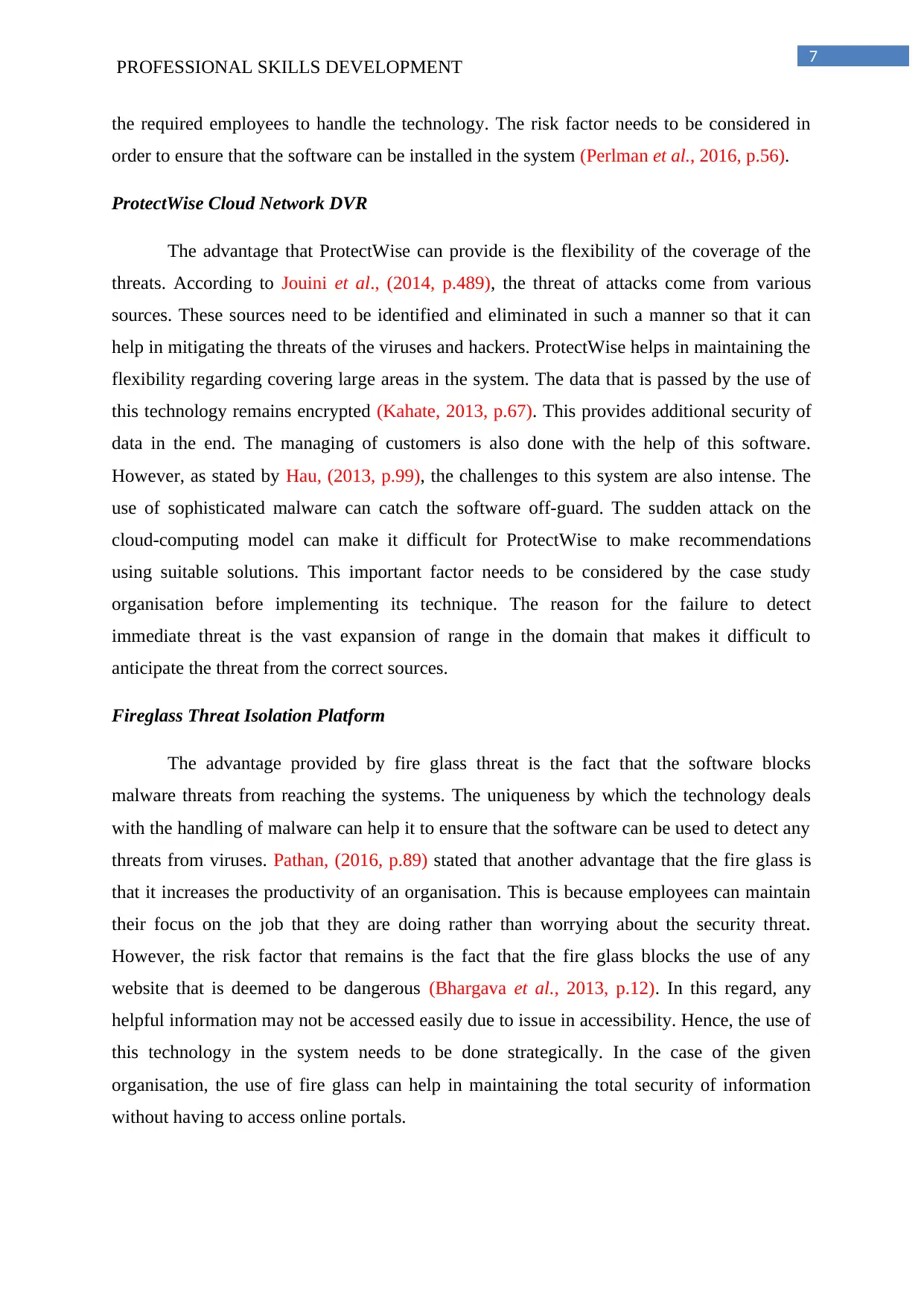
7
PROFESSIONAL SKILLS DEVELOPMENT
the required employees to handle the technology. The risk factor needs to be considered in
order to ensure that the software can be installed in the system (Perlman et al., 2016, p.56).
ProtectWise Cloud Network DVR
The advantage that ProtectWise can provide is the flexibility of the coverage of the
threats. According to Jouini et al., (2014, p.489), the threat of attacks come from various
sources. These sources need to be identified and eliminated in such a manner so that it can
help in mitigating the threats of the viruses and hackers. ProtectWise helps in maintaining the
flexibility regarding covering large areas in the system. The data that is passed by the use of
this technology remains encrypted (Kahate, 2013, p.67). This provides additional security of
data in the end. The managing of customers is also done with the help of this software.
However, as stated by Hau, (2013, p.99), the challenges to this system are also intense. The
use of sophisticated malware can catch the software off-guard. The sudden attack on the
cloud-computing model can make it difficult for ProtectWise to make recommendations
using suitable solutions. This important factor needs to be considered by the case study
organisation before implementing its technique. The reason for the failure to detect
immediate threat is the vast expansion of range in the domain that makes it difficult to
anticipate the threat from the correct sources.
Fireglass Threat Isolation Platform
The advantage provided by fire glass threat is the fact that the software blocks
malware threats from reaching the systems. The uniqueness by which the technology deals
with the handling of malware can help it to ensure that the software can be used to detect any
threats from viruses. Pathan, (2016, p.89) stated that another advantage that the fire glass is
that it increases the productivity of an organisation. This is because employees can maintain
their focus on the job that they are doing rather than worrying about the security threat.
However, the risk factor that remains is the fact that the fire glass blocks the use of any
website that is deemed to be dangerous (Bhargava et al., 2013, p.12). In this regard, any
helpful information may not be accessed easily due to issue in accessibility. Hence, the use of
this technology in the system needs to be done strategically. In the case of the given
organisation, the use of fire glass can help in maintaining the total security of information
without having to access online portals.
PROFESSIONAL SKILLS DEVELOPMENT
the required employees to handle the technology. The risk factor needs to be considered in
order to ensure that the software can be installed in the system (Perlman et al., 2016, p.56).
ProtectWise Cloud Network DVR
The advantage that ProtectWise can provide is the flexibility of the coverage of the
threats. According to Jouini et al., (2014, p.489), the threat of attacks come from various
sources. These sources need to be identified and eliminated in such a manner so that it can
help in mitigating the threats of the viruses and hackers. ProtectWise helps in maintaining the
flexibility regarding covering large areas in the system. The data that is passed by the use of
this technology remains encrypted (Kahate, 2013, p.67). This provides additional security of
data in the end. The managing of customers is also done with the help of this software.
However, as stated by Hau, (2013, p.99), the challenges to this system are also intense. The
use of sophisticated malware can catch the software off-guard. The sudden attack on the
cloud-computing model can make it difficult for ProtectWise to make recommendations
using suitable solutions. This important factor needs to be considered by the case study
organisation before implementing its technique. The reason for the failure to detect
immediate threat is the vast expansion of range in the domain that makes it difficult to
anticipate the threat from the correct sources.
Fireglass Threat Isolation Platform
The advantage provided by fire glass threat is the fact that the software blocks
malware threats from reaching the systems. The uniqueness by which the technology deals
with the handling of malware can help it to ensure that the software can be used to detect any
threats from viruses. Pathan, (2016, p.89) stated that another advantage that the fire glass is
that it increases the productivity of an organisation. This is because employees can maintain
their focus on the job that they are doing rather than worrying about the security threat.
However, the risk factor that remains is the fact that the fire glass blocks the use of any
website that is deemed to be dangerous (Bhargava et al., 2013, p.12). In this regard, any
helpful information may not be accessed easily due to issue in accessibility. Hence, the use of
this technology in the system needs to be done strategically. In the case of the given
organisation, the use of fire glass can help in maintaining the total security of information
without having to access online portals.
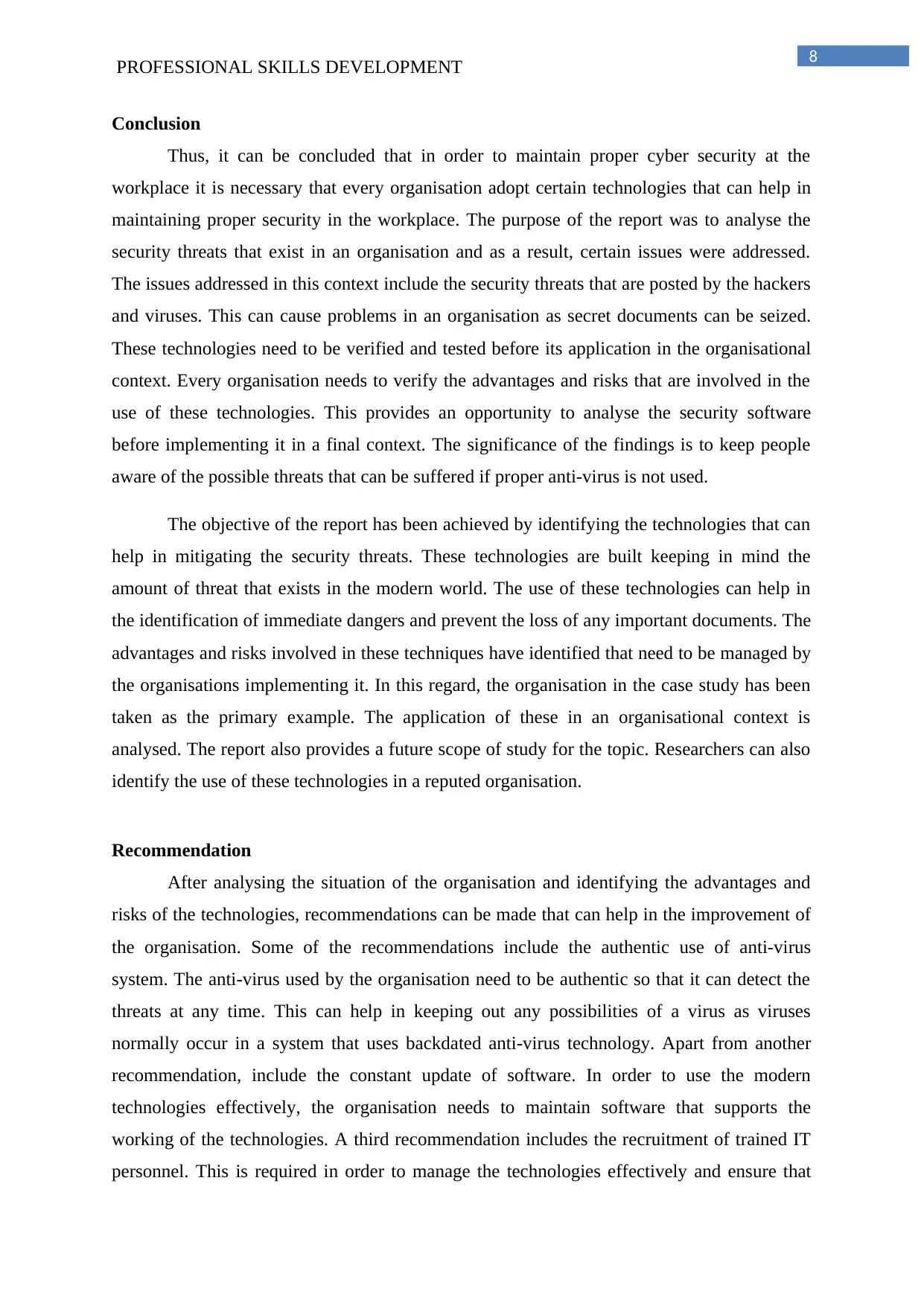
8
PROFESSIONAL SKILLS DEVELOPMENT
Conclusion
Thus, it can be concluded that in order to maintain proper cyber security at the
workplace it is necessary that every organisation adopt certain technologies that can help in
maintaining proper security in the workplace. The purpose of the report was to analyse the
security threats that exist in an organisation and as a result, certain issues were addressed.
The issues addressed in this context include the security threats that are posted by the hackers
and viruses. This can cause problems in an organisation as secret documents can be seized.
These technologies need to be verified and tested before its application in the organisational
context. Every organisation needs to verify the advantages and risks that are involved in the
use of these technologies. This provides an opportunity to analyse the security software
before implementing it in a final context. The significance of the findings is to keep people
aware of the possible threats that can be suffered if proper anti-virus is not used.
The objective of the report has been achieved by identifying the technologies that can
help in mitigating the security threats. These technologies are built keeping in mind the
amount of threat that exists in the modern world. The use of these technologies can help in
the identification of immediate dangers and prevent the loss of any important documents. The
advantages and risks involved in these techniques have identified that need to be managed by
the organisations implementing it. In this regard, the organisation in the case study has been
taken as the primary example. The application of these in an organisational context is
analysed. The report also provides a future scope of study for the topic. Researchers can also
identify the use of these technologies in a reputed organisation.
Recommendation
After analysing the situation of the organisation and identifying the advantages and
risks of the technologies, recommendations can be made that can help in the improvement of
the organisation. Some of the recommendations include the authentic use of anti-virus
system. The anti-virus used by the organisation need to be authentic so that it can detect the
threats at any time. This can help in keeping out any possibilities of a virus as viruses
normally occur in a system that uses backdated anti-virus technology. Apart from another
recommendation, include the constant update of software. In order to use the modern
technologies effectively, the organisation needs to maintain software that supports the
working of the technologies. A third recommendation includes the recruitment of trained IT
personnel. This is required in order to manage the technologies effectively and ensure that
PROFESSIONAL SKILLS DEVELOPMENT
Conclusion
Thus, it can be concluded that in order to maintain proper cyber security at the
workplace it is necessary that every organisation adopt certain technologies that can help in
maintaining proper security in the workplace. The purpose of the report was to analyse the
security threats that exist in an organisation and as a result, certain issues were addressed.
The issues addressed in this context include the security threats that are posted by the hackers
and viruses. This can cause problems in an organisation as secret documents can be seized.
These technologies need to be verified and tested before its application in the organisational
context. Every organisation needs to verify the advantages and risks that are involved in the
use of these technologies. This provides an opportunity to analyse the security software
before implementing it in a final context. The significance of the findings is to keep people
aware of the possible threats that can be suffered if proper anti-virus is not used.
The objective of the report has been achieved by identifying the technologies that can
help in mitigating the security threats. These technologies are built keeping in mind the
amount of threat that exists in the modern world. The use of these technologies can help in
the identification of immediate dangers and prevent the loss of any important documents. The
advantages and risks involved in these techniques have identified that need to be managed by
the organisations implementing it. In this regard, the organisation in the case study has been
taken as the primary example. The application of these in an organisational context is
analysed. The report also provides a future scope of study for the topic. Researchers can also
identify the use of these technologies in a reputed organisation.
Recommendation
After analysing the situation of the organisation and identifying the advantages and
risks of the technologies, recommendations can be made that can help in the improvement of
the organisation. Some of the recommendations include the authentic use of anti-virus
system. The anti-virus used by the organisation need to be authentic so that it can detect the
threats at any time. This can help in keeping out any possibilities of a virus as viruses
normally occur in a system that uses backdated anti-virus technology. Apart from another
recommendation, include the constant update of software. In order to use the modern
technologies effectively, the organisation needs to maintain software that supports the
working of the technologies. A third recommendation includes the recruitment of trained IT
personnel. This is required in order to manage the technologies effectively and ensure that
⊘ This is a preview!⊘
Do you want full access?
Subscribe today to unlock all pages.

Trusted by 1+ million students worldwide
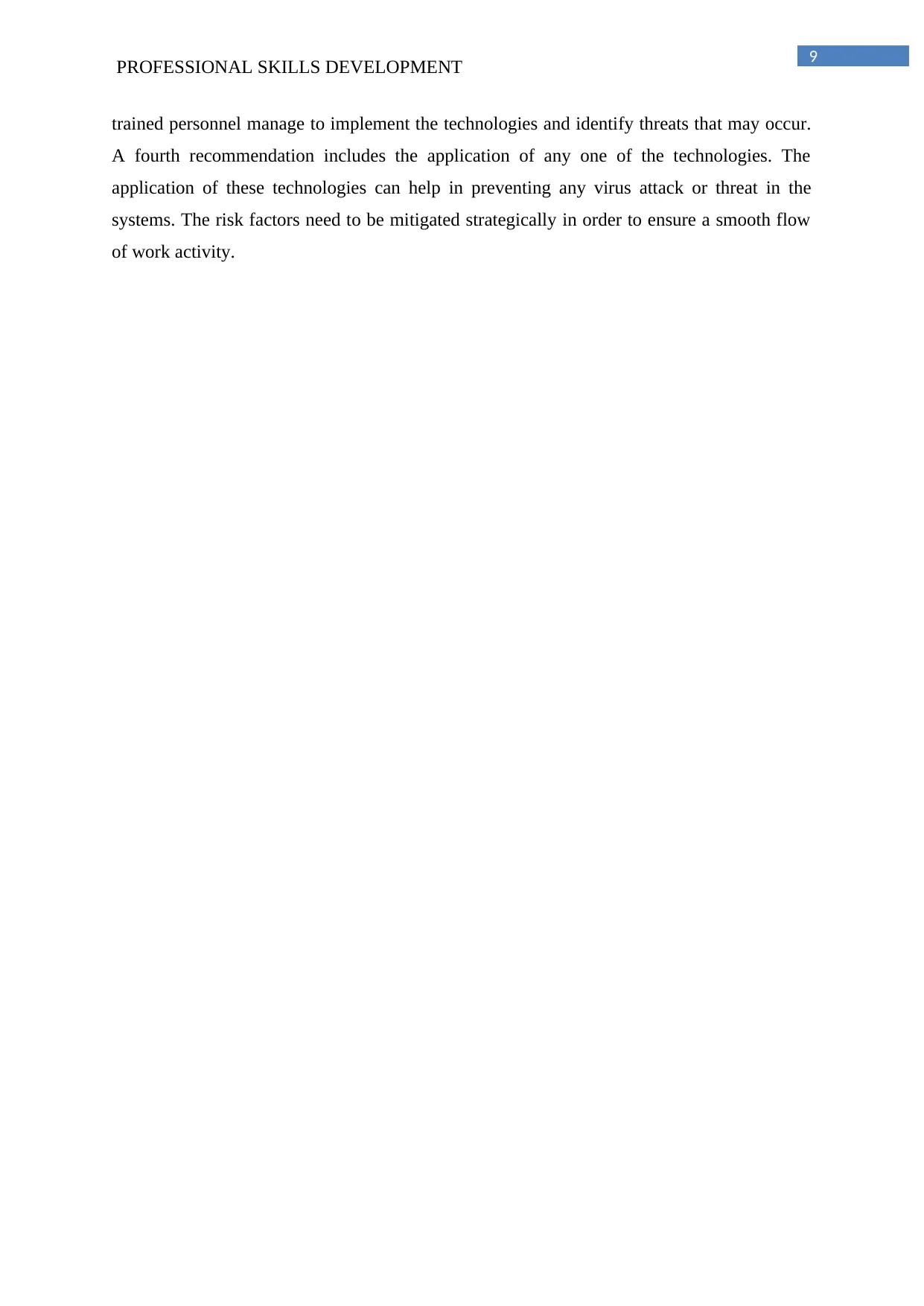
9
PROFESSIONAL SKILLS DEVELOPMENT
trained personnel manage to implement the technologies and identify threats that may occur.
A fourth recommendation includes the application of any one of the technologies. The
application of these technologies can help in preventing any virus attack or threat in the
systems. The risk factors need to be mitigated strategically in order to ensure a smooth flow
of work activity.
PROFESSIONAL SKILLS DEVELOPMENT
trained personnel manage to implement the technologies and identify threats that may occur.
A fourth recommendation includes the application of any one of the technologies. The
application of these technologies can help in preventing any virus attack or threat in the
systems. The risk factors need to be mitigated strategically in order to ensure a smooth flow
of work activity.
Paraphrase This Document
Need a fresh take? Get an instant paraphrase of this document with our AI Paraphraser
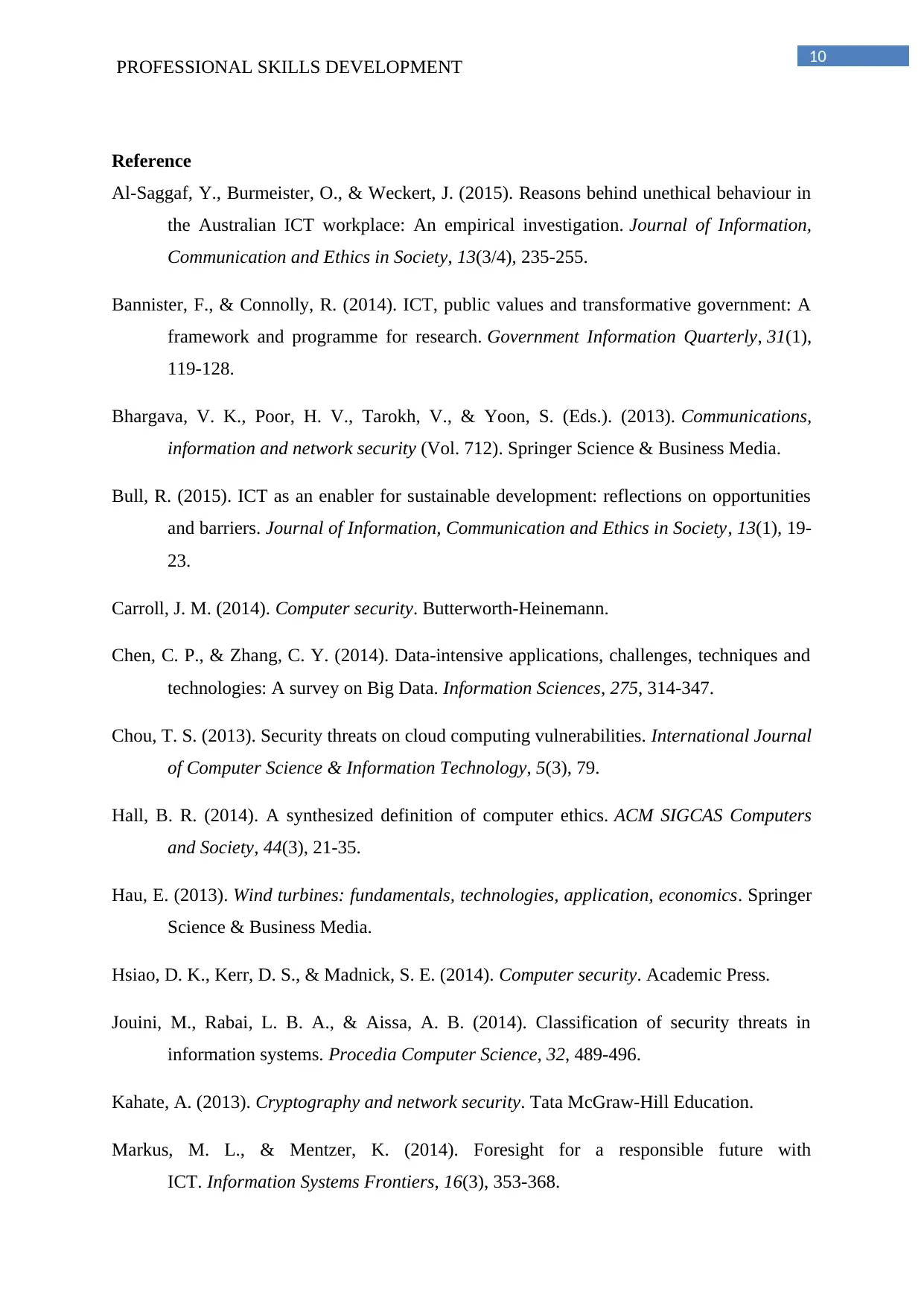
10
PROFESSIONAL SKILLS DEVELOPMENT
Reference
Al-Saggaf, Y., Burmeister, O., & Weckert, J. (2015). Reasons behind unethical behaviour in
the Australian ICT workplace: An empirical investigation. Journal of Information,
Communication and Ethics in Society, 13(3/4), 235-255.
Bannister, F., & Connolly, R. (2014). ICT, public values and transformative government: A
framework and programme for research. Government Information Quarterly, 31(1),
119-128.
Bhargava, V. K., Poor, H. V., Tarokh, V., & Yoon, S. (Eds.). (2013). Communications,
information and network security (Vol. 712). Springer Science & Business Media.
Bull, R. (2015). ICT as an enabler for sustainable development: reflections on opportunities
and barriers. Journal of Information, Communication and Ethics in Society, 13(1), 19-
23.
Carroll, J. M. (2014). Computer security. Butterworth-Heinemann.
Chen, C. P., & Zhang, C. Y. (2014). Data-intensive applications, challenges, techniques and
technologies: A survey on Big Data. Information Sciences, 275, 314-347.
Chou, T. S. (2013). Security threats on cloud computing vulnerabilities. International Journal
of Computer Science & Information Technology, 5(3), 79.
Hall, B. R. (2014). A synthesized definition of computer ethics. ACM SIGCAS Computers
and Society, 44(3), 21-35.
Hau, E. (2013). Wind turbines: fundamentals, technologies, application, economics. Springer
Science & Business Media.
Hsiao, D. K., Kerr, D. S., & Madnick, S. E. (2014). Computer security. Academic Press.
Jouini, M., Rabai, L. B. A., & Aissa, A. B. (2014). Classification of security threats in
information systems. Procedia Computer Science, 32, 489-496.
Kahate, A. (2013). Cryptography and network security. Tata McGraw-Hill Education.
Markus, M. L., & Mentzer, K. (2014). Foresight for a responsible future with
ICT. Information Systems Frontiers, 16(3), 353-368.
PROFESSIONAL SKILLS DEVELOPMENT
Reference
Al-Saggaf, Y., Burmeister, O., & Weckert, J. (2015). Reasons behind unethical behaviour in
the Australian ICT workplace: An empirical investigation. Journal of Information,
Communication and Ethics in Society, 13(3/4), 235-255.
Bannister, F., & Connolly, R. (2014). ICT, public values and transformative government: A
framework and programme for research. Government Information Quarterly, 31(1),
119-128.
Bhargava, V. K., Poor, H. V., Tarokh, V., & Yoon, S. (Eds.). (2013). Communications,
information and network security (Vol. 712). Springer Science & Business Media.
Bull, R. (2015). ICT as an enabler for sustainable development: reflections on opportunities
and barriers. Journal of Information, Communication and Ethics in Society, 13(1), 19-
23.
Carroll, J. M. (2014). Computer security. Butterworth-Heinemann.
Chen, C. P., & Zhang, C. Y. (2014). Data-intensive applications, challenges, techniques and
technologies: A survey on Big Data. Information Sciences, 275, 314-347.
Chou, T. S. (2013). Security threats on cloud computing vulnerabilities. International Journal
of Computer Science & Information Technology, 5(3), 79.
Hall, B. R. (2014). A synthesized definition of computer ethics. ACM SIGCAS Computers
and Society, 44(3), 21-35.
Hau, E. (2013). Wind turbines: fundamentals, technologies, application, economics. Springer
Science & Business Media.
Hsiao, D. K., Kerr, D. S., & Madnick, S. E. (2014). Computer security. Academic Press.
Jouini, M., Rabai, L. B. A., & Aissa, A. B. (2014). Classification of security threats in
information systems. Procedia Computer Science, 32, 489-496.
Kahate, A. (2013). Cryptography and network security. Tata McGraw-Hill Education.
Markus, M. L., & Mentzer, K. (2014). Foresight for a responsible future with
ICT. Information Systems Frontiers, 16(3), 353-368.
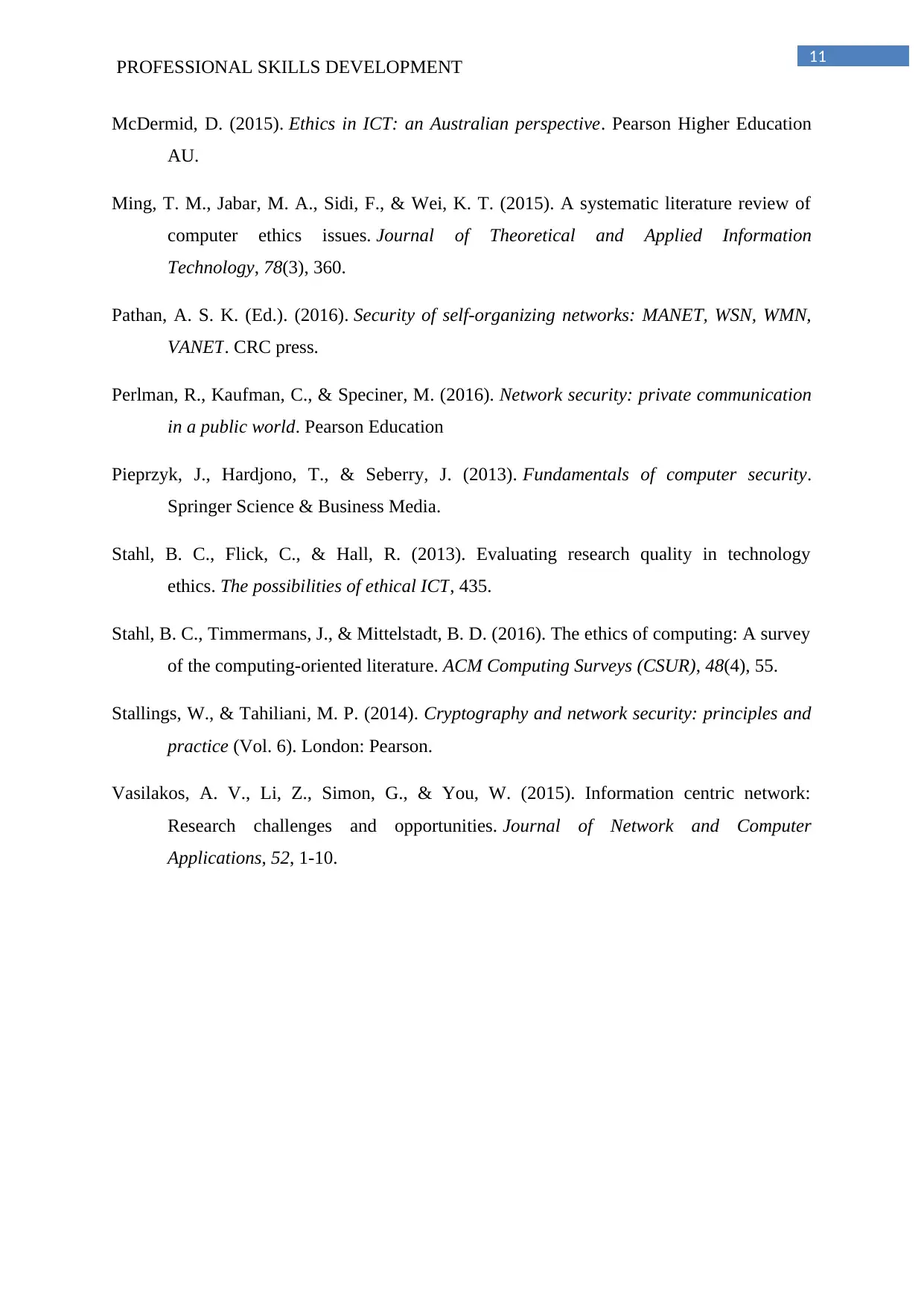
11
PROFESSIONAL SKILLS DEVELOPMENT
McDermid, D. (2015). Ethics in ICT: an Australian perspective. Pearson Higher Education
AU.
Ming, T. M., Jabar, M. A., Sidi, F., & Wei, K. T. (2015). A systematic literature review of
computer ethics issues. Journal of Theoretical and Applied Information
Technology, 78(3), 360.
Pathan, A. S. K. (Ed.). (2016). Security of self-organizing networks: MANET, WSN, WMN,
VANET. CRC press.
Perlman, R., Kaufman, C., & Speciner, M. (2016). Network security: private communication
in a public world. Pearson Education
Pieprzyk, J., Hardjono, T., & Seberry, J. (2013). Fundamentals of computer security.
Springer Science & Business Media.
Stahl, B. C., Flick, C., & Hall, R. (2013). Evaluating research quality in technology
ethics. The possibilities of ethical ICT, 435.
Stahl, B. C., Timmermans, J., & Mittelstadt, B. D. (2016). The ethics of computing: A survey
of the computing-oriented literature. ACM Computing Surveys (CSUR), 48(4), 55.
Stallings, W., & Tahiliani, M. P. (2014). Cryptography and network security: principles and
practice (Vol. 6). London: Pearson.
Vasilakos, A. V., Li, Z., Simon, G., & You, W. (2015). Information centric network:
Research challenges and opportunities. Journal of Network and Computer
Applications, 52, 1-10.
PROFESSIONAL SKILLS DEVELOPMENT
McDermid, D. (2015). Ethics in ICT: an Australian perspective. Pearson Higher Education
AU.
Ming, T. M., Jabar, M. A., Sidi, F., & Wei, K. T. (2015). A systematic literature review of
computer ethics issues. Journal of Theoretical and Applied Information
Technology, 78(3), 360.
Pathan, A. S. K. (Ed.). (2016). Security of self-organizing networks: MANET, WSN, WMN,
VANET. CRC press.
Perlman, R., Kaufman, C., & Speciner, M. (2016). Network security: private communication
in a public world. Pearson Education
Pieprzyk, J., Hardjono, T., & Seberry, J. (2013). Fundamentals of computer security.
Springer Science & Business Media.
Stahl, B. C., Flick, C., & Hall, R. (2013). Evaluating research quality in technology
ethics. The possibilities of ethical ICT, 435.
Stahl, B. C., Timmermans, J., & Mittelstadt, B. D. (2016). The ethics of computing: A survey
of the computing-oriented literature. ACM Computing Surveys (CSUR), 48(4), 55.
Stallings, W., & Tahiliani, M. P. (2014). Cryptography and network security: principles and
practice (Vol. 6). London: Pearson.
Vasilakos, A. V., Li, Z., Simon, G., & You, W. (2015). Information centric network:
Research challenges and opportunities. Journal of Network and Computer
Applications, 52, 1-10.
⊘ This is a preview!⊘
Do you want full access?
Subscribe today to unlock all pages.

Trusted by 1+ million students worldwide
1 out of 12
Related Documents
Your All-in-One AI-Powered Toolkit for Academic Success.
+13062052269
info@desklib.com
Available 24*7 on WhatsApp / Email
![[object Object]](/_next/static/media/star-bottom.7253800d.svg)
Unlock your academic potential
Copyright © 2020–2025 A2Z Services. All Rights Reserved. Developed and managed by ZUCOL.





